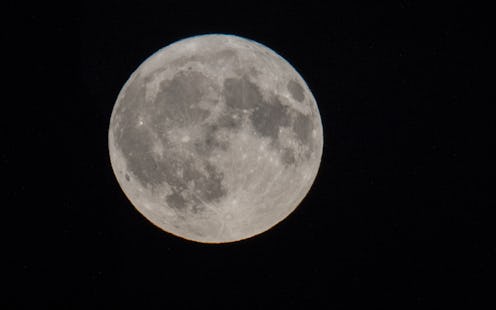Life
Here's The BEST Place To See This Week's Full Moon

For as long as I can remember, my favorite kind of worm has been the gummy worm. (Does anyone else remember "dirt dessert?" Who knew that chocolate pudding and chocolate cookie crumbs and gummy worms could make such a flawless combo? Actually, I could go for some dirt dessert right about now.) Most other worm-related things have always seemed kind of... gross. Recently, however, I learned of something called a full worm moon, and I have another item to add to my "worm-related things I like" list. Now that this astronomical phenomenon is on my radar, I'm wondering where I can see the March 2018 full worm moon, so I've done a little digging and am here to give you all the info.
First, let's get clear on the basics of the full worm moon and why we refer to it that way. Like the better known frost moon, harvest moon, and strawberry moon, the worm moon doesn't actually look that much different from any other full moon — it simply has a catchier name. Per the Farmer's Almanac, the annual full worm moon (always the full moon that falls in the month of March) is so named because of the weather conditions that typically come with it. Native — and later on, colonial — Americans started using the nickname for the full moon that rose at roughly the same time that the ground began softening enough for earthworms to reappear. In the years before real-time weather forecasting and local meteorologists, this moon was an exciting signal of the beginning of planting season. Centuries ago, this was a pretty big deal, as it meant that communities would be able to grow their own provisions again after a long, cold winter.
While we might not be waiting on the full worm moon to cue us to start planting or hunting for earthworms in 2018, it's still worth knowing when and how to look for it, right? A perfectly full moon is pretty beautiful regardless of the year.
This year's full worm moon will rise on Mar. 1 at 7:51 p.m. EST, according to the Farmer's Almanac. The good news is that you have a chance of catching a glimpse wherever you live! Per EarthSky, "no matter where you live worldwide, you can always expect to see a full moon lighting up the nighttime from dusk until dawn." The moon will rise in the east, so it will be easier for people living in locations further east to see it early in the night. And since the moon will set in the west, western locations will have a better view as the night goes on.
Your odds of seeing the Mar. 1 full moon are obviously good, but you'll have a second chance at seeing a bright, perfect orb later on in the month should you miss that worm moon. Typically, we see one full moon rise per month, but we do occasionally experience two in that same period. We call the second full moon in a single calendar month a blue moon, according to EarthSky. In addition to the Mar. 1 worm moon, we'll experience a blue moon again on Mar. 31 at 8:37 a.m. EST, per the Farmer's Almanac. This full moon is called the sap moon, so nicknamed because early spring is the time that maple syrup-producing regions see maple trees begin to fill up with sap. When this happens, the trees are ready to be tapped so that the process of making your favorite breakfast condiment can begin!
When you look up at the sky (from basically anywhere!) on Mar. 1 and see a bright, beautiful full moon rising, you might even start to appreciate the night sky as much as you appreciate a good dirt dessert. I know it's hard to beat dirt dessert, but you really never know. Anything can happen during a full moon!